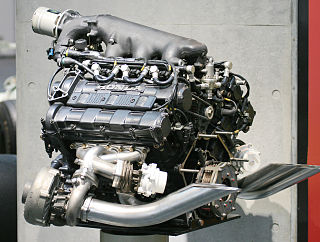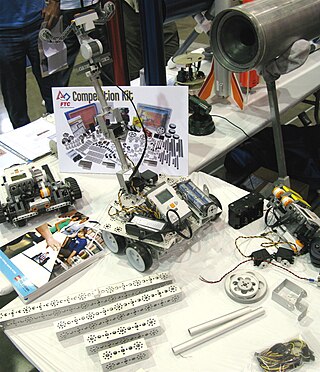This article needs additional citations for verification .(March 2012) |



Robotino is a mobile robot system made by Festo Didactic, and used for educational, training and research purposes.
This article needs additional citations for verification .(March 2012) |



Robotino is a mobile robot system made by Festo Didactic, and used for educational, training and research purposes.
Robotino is based on an omnidirectional drive assembly, which enables the system to roam freely. The robot is controlled by an industry-standard PC system, which is powerful enough to plan routes for fully autonomous driving. Via a WLAN-Link, Robotino can send all sensor readings to an external PC. In the other direction, control commands can be issued by the external PC. This way, control programs can run on the external PC or on Robotino directly. Mixed mode or shared control are also possible.
For users with little prior robotics knowledge, Robotino can be readily programmed in its “native” programming environment RobotinoView II. More experienced programmers may find it useful that the robot can also be programmed in C, C++, Java, .NET, Matlab, Simulink, Labview and Microsoft Robotics Developer Studio.
The omnidirectional drive consists of three Mecanum wheels, all of which are individually controllable. These wheels are arranged at angles of 120°. Robotino has a bumper sensor around its circumference, infrared distance sensors, a color camera with VGA resolution, optical wheel encoders, power measurement for the entire system and the various motors, as well as a battery voltage monitor. Moreover, as optional additional sensors, Robotino can be equipped with a precise laser scanner, a gyroscope, and an indoor positioning system (created by Evolution Robotics). For signal input and output Robotino has several interfaces:
Power is supplied by two 12V/5Ah lead-acid batteries or optionally by two 12V/9Ah NiMH batteries.

A programmable logic controller (PLC) or programmable controller is an industrial computer that has been ruggedized and adapted for the control of manufacturing processes, such as assembly lines, machines, robotic devices, or any activity that requires high reliability, ease of programming, and process fault diagnosis. Dick Morley is considered as the father of PLC as he had invented the first PLC, the Modicon 084, for General Motors in 1968.

An embedded system is a computer system—a combination of a computer processor, computer memory, and input/output peripheral devices—that has a dedicated function within a larger mechanical or electronic system. It is embedded as part of a complete device often including electrical or electronic hardware and mechanical parts. Because an embedded system typically controls physical operations of the machine that it is embedded within, it often has real-time computing constraints. Embedded systems control many devices in common use. In 2009, it was estimated that ninety-eight percent of all microprocessors manufactured were used in embedded systems.

A machine is a physical system using power to apply forces and control movement to perform an action. The term is commonly applied to artificial devices, such as those employing engines or motors, but also to natural biological macromolecules, such as molecular machines. Machines can be driven by animals and people, by natural forces such as wind and water, and by chemical, thermal, or electrical power, and include a system of mechanisms that shape the actuator input to achieve a specific application of output forces and movement. They can also include computers and sensors that monitor performance and plan movement, often called mechanical systems.

Pulse-width modulation (PWM), or pulse-duration modulation (PDM), is a method of controlling the average power delivered by an electrical signal. The average value of voltage fed to the load is controlled by switching the supply between 0 and 100% at a rate faster than it takes the load to change significantly. The longer the switch is on, the higher the total power supplied to the load. Along with maximum power point tracking (MPPT), it is one of the primary methods of controlling the output of solar panels to that which can be utilized by a battery. PWM is particularly suited for running inertial loads such as motors, which are not as easily affected by this discrete switching. The goal of PWM is to control a load; however, the PWM switching frequency must be selected carefully in order to smoothly do so.

Lego Mindstorms is a discontinued hardware and software structure which develops programmable robots based on Lego building blocks. Each version includes an intelligent brick, a set of modular sensors and motors, and parts from the Lego Technic line to create the mechanical systems. The system is controlled by the intelligent brick, which act as the brain of the mechanical system.
In control engineering, a servomechanism, usually shortened to servo, is an automatic device that uses error-sensing negative feedback to correct the action of a mechanism. In displacement-controlled applications, it usually includes a built-in encoder or other position feedback mechanism to ensure the output is achieving the desired effect.

A rotary encoder, also called a shaft encoder, is an electro-mechanical device that converts the angular position or motion of a shaft or axle to analog or digital output signals.
A general-purpose input/output (GPIO) is an uncommitted digital signal pin on an integrated circuit or electronic circuit board which may be used as an input or output, or both, and is controllable by software.
A wheel speed sensor (WSS) or vehicle speed sensor (VSS) is a type of tachometer. It is a sender device used for reading the speed of a vehicle's wheel rotation. It usually consists of a toothed ring and pickup.

BIG TRAK / bigtrak is a programmable toy electric vehicle created by Milton Bradley in 1979, resembling a futuristic Sci-Fi tank / utility vehicle, possibly for use on the Moon or a Planetoid style environment. The original Big Trak was a six-wheeled tank with a front-mounted blue "photon beam" headlamp, and a keypad on top. The toy could remember up to 16 commands, which it then executed in sequence. There also was an optional cargo trailer accessory, with the UK version being white to match its colour scheme; once hooked to the Bigtrak, this trailer could be programmed to dump its payload.
An electronic speed control (ESC) is an electronic circuit that controls and regulates the speed of an electric motor. It may also provide reversing of the motor and dynamic braking. Miniature electronic speed controls are used in electrically powered radio controlled models. Full-size electric vehicles also have systems to control the speed of their drive motors.

A servomotor is a rotary actuator or linear actuator that allows for precise control of angular or linear position, velocity, and acceleration. It consists of a suitable motor coupled to a sensor for position feedback. It also requires a relatively sophisticated controller, often a dedicated module designed specifically for use with servomotors.
Building automation(BAS), also known as building management system (BMS) or building energy management system (BEMS), is the automatic centralized control of a building's HVAC (heating, ventilation and air conditioning), electrical, lighting, shading, access control, security systems, and other interrelated systems. Some objectives of building automation are improved occupant comfort, efficient operation of building systems, reduction in energy consumption, reduced operating and maintaining costs and increased security.

A servo drive is an electronic amplifier used to power electric servomechanisms.

Brake-by-wire technology in the automotive industry is the ability to control brakes through electronic means, without a mechanical connection that transfers force to the physical braking system from a driver input apparatus such as a pedal or lever.
S-AWC is the brand name of an advanced full-time four-wheel drive system developed by Mitsubishi Motors. The technology, specifically developed for the new 2007 Lancer Evolution, the 2010 Outlander, the 2014 Outlander, the Outlander PHEV and the Eclipse Cross have an advanced version of Mitsubishi Motors' AWC system. Mitsubishi Motors first exhibited S-AWC integration control technology in the Concept-X model at the 39th Tokyo Motor Show in 2005. According to Mitsubishi Motors, "the ultimate embodiment of the company's AWC philosophy is the S-AWC system, a 4WD-based integrated vehicle dynamics control system".

IOIO is a series of open source PIC microcontroller-based boards that allow Android mobile applications to interact with external electronics. The device was invented by Ytai Ben-Tsvi in 2011, and was first manufactured by SparkFun Electronics. The name "IOIO" is inspired by the function of the device, which enables applications to receive external input ("I") and produce external output ("O").
Festo is a German automation company based in Esslingen am Neckar, Germany. Festo produces and sells pneumatic and electrical control systems and drive technology for factories and process automation. Festo Didactic also offers industrial education and consultation services and is one of the sponsors and partners of the WorldSkills Mechatronics Competitions. Sales subsidiaries, distribution centres and factories of Festo are located in 61 countries worldwide. The company was named after its founders Albert Fezer and Gottlieb Stoll.
Honda Advanced Technology is part of Honda's long-standing research and development program focused on building new models for their automotive products and automotive-related technologies, with many of the advances pertaining to engine technology. Honda's research has led to practical solutions ranging from fuel-efficient vehicles and engines, to more sophisticated applications such as the humanoid robot, ASIMO, and the Honda HA-420 Honda-jet, a six-passenger business jet.

TETRIX Robotics consists of two robotic kits by Pitsco Education. The two sets are the TETRIX® MAX building system and the TETRIX® PRIME building system. They are intended to be used as educational robotics and for competitions such as the FIRST Tech Challenge.